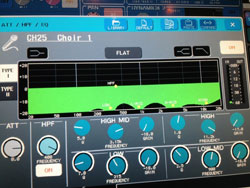5 Key Ways To Improve Choir Sound

If you ask any church sound engineer what one thing they hate dealing with the most, there's a better than likely chance they will say getting a good choir sound causes them the most trouble. In fact, it's not just the sound guys who get frustrated with a choir. I know plenty of worship leaders who struggle with having a choir as well. Not only is getting great sound from a choir tricky, but leading, organizing and rehearsing that big of a group is a lot of work.
So why do we all put ourselves through the "hassle" of a choir? Because when done right, not only are you giving a larger percentage of your church the opportunity to lead people in an expression of worship, but when it's done well it can seriously enhance your worship service. Having an extra 20-100 people on stage, worshiping God with all their heart and providing a huge vocal presence can really be an incredible, engaging boost to your worship times. But how do we get there? Well here are five keys I've found to getting a good sound from your choir.

#1) Your Output Is Only As Good As Your Input
If you've been reading these Worship Tools newsletters for any length of time, you've heard me say countless times some variation of garbage in equals garbage out. The same concept is especially true when it comes to choirs. If you're choir doesn't sing with strength, passion and energy, your choir sound will sound weak and dull. We're not even talking about pitch or singing the right words yet (or even having everyone clapping on the same beat?), but your sound energy out will not exceed your sound energy in. If you're going to have a choir and you expect them to sound good, you need to work with your choir to project and be a strong, unified voice. If this is a sticking point for you, either know that your choir is there only for visual enhancement or perhaps consider not having a choir at all.
#2) Location, Location, Location!
I have a lot of conversations with churches about their choir. We start discussing what they feel they are lacking in sound and all of the things they have tried to improve it. It's at this point I generally ask for a picture or video from a standard service. Nearly every time I get a picture (or video), I'll see a good-sized choir energetically worshiping God... right next to a non-caged drum set or right behind the brass or winds section of the orchestra. Here's the thing, you can't put one of the quieter inputs on stage next to one of the loudest and expect to hear more choir than the instrument it's competing with. When I point this out, most people respond with a "well, duh, why didn't I think of that" type response and go back and see immediate improvement by laying their stage out differently.

#3) Be An Assassin With EQ
Just in case you think I'm advocating hitting someone in your choir with an EQ box, I'm not. You can help your problem by using EQ, just not that way. The challenge is to not get so over the top with it that you kill the entire mic sound. I got to work with a great college choir group at my church two weeks ago and when I looked at the EQ on their console, I immediately understood why the choir sounded so muffled. When using EQ on your choir microphones, you must be tactical with your cuts in order to eliminate feedback prone frequencies and leave the rest of the sound that you want intact. This is where the "Q" setting on a digital console EQ can be very helpful, helping you only kill the frequencies causing you problems.
#4) The Right Mic In The Right Place
This is where it gets a little more complicated, so I want to take a look at both pieces individually. Let's begin first with getting the "right mic". This is purely subjective, as the "right mic" is the one that provides the sound you're looking for with the input you have. That being said, some microphones certainly provide better results than others. Personally, I'm a big fan of two or three different options from DPA Microphones and the Audix Microboom is a favorite as well. If you're looking for something a little more budget-friendly, we've had success with the Audio Technica Pro 37 and AKG C1000S. For hanging microphones, the DPA 4098H is my go-to microphone. Regardless of your preference, you typically want to look for a directional mic (cardioid or supercardioid) and one that will afford you good gain before feedback.
The mic placement is just as important as choosing a good microphone system. Assuming you've chosen a good, directional mic, the next challenge is to locate it in a place that will maximize the pickup of choir sound and reject as much sound from the house and/or monitors as possible. If your microphones and monitors are on stands on the floor, this is as easy as pointing the back of the mic down towards the floor monitors while the pick-up side of the mic points slightly up towards the choir. If your monitors are flown, you would want to raise the mic a little higher than normal and point it more down, so the back of the mic is once again pointing towards the monitor in order to maximize rejection.
#5) You Can Have Too Much Of A Good Thing
If three microphones on my choir are good, then 6 will be better, right? Not necessarily. It's important to remember the 3:1 rule when it comes to setting up your microphones. If you place mic ‘A’ three feet away from your choir, mic ‘B’ should be nine feet away from mic ‘A’ in order to minimize phase issues happening between the microphones. I have been in venues where simply muting one microphone has completely opened up the sound of the choir and given 4-5 dB of headroom.
Bonus Tip!
If you've tried everything I've mentioned above and still can't get enough gain before feedback out of your choir, don't give up! Yamaha Commercial Audio has partnered with Rupert Neve Designs to create the Portico 5045 Primary Source Enhancer, reducing unwanted sounds in your microphones and giving you up to an additional 20 dB of extra gain before feedback. While not cheap, it is stunningly effective and has been referred to by some of my good friends as the "magic box."
If you work with a choir regularly but don't feel like you're getting the kind of sound you want, try out these 5 tips to help you maximize your input, reject unwanted noise and maximize your gain before feedback. And worst case scenario, you can always try a little magic. Happy mixing!


Duke DeJongVice President, Sales & Integration
CCI Solutions
ddejong@ccisolutions.com
Duke has over 18 years of experience as a technical artist, trainer and collaborator for ministries. Duke travels around the country for CCI Solutions and is available to help your ministry. Join Duke on Facebook at
www.facebook.com/ccisolutions.